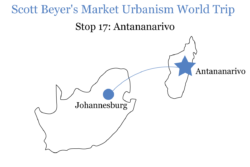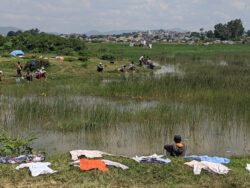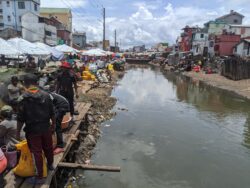The Poverty of Madagascar
Government policy is a huge factor, but it’s also something that can be reversed.
From my first day walking the streets of the Madagascar capital Antananarivo, I found the same predicament. The city has intense, visible poverty, and once locals see the rare white tourist, they approach for money. Many of them are street kids, dirty and barefoot, so I began handing out food. Often pandemonium would ensue: I’d suddenly find myself surrounded by dozens of mothers, children, even grown men, fighting over themselves and snatching at the food, creating a dangerous situation.
While I didn’t know things would be this extreme, it’s mostly what I expected. The point of my 1.5-year Global South trip is to visit developing world countries that have upward trajectories. But I wanted to visit at least one among the world’s 10 poorest, to assess living standards, corporate saturation levels, etc. I chose Madagascar because, at $1,500 per capita GDP, it’s in that category but is relatively safe.
But why is Madagascar, a resource-rich African island country with proximity to Asian markets, so poor? That question too I wanted to explore.
Madagascar in some ways reflects the African story overall, but in others is different from the continental mainland. Its original demographics include many African ethnic groups and later on it faced colonialism, principally with the French occupation that began in the late 1890s and ended in 1960s revolution. But the population draws from Asian influences too—including the Middle East and Polynesia—creating a unique ethnic makeup that locals call malagasy.

A 29-million-person island nation on the Indian Ocean, Madagascar might sooner be a key trading pass-through for Africa and Asia. Instead it seems stranded, often flirting with “world’s poorest country” designations and suffering from many social problems. High school enrollment rate is only 50%, and it’s even quite low for elementary grade levels, as food scarcity causes kids to drop out and spend their days scavenging the streets. Madagascar’s in the bottom 10% among countries in the Human Development Index, a U.N. ranking measuring various health and economic factors. 25% of the economy is agricultural (compared to 0.7% for the U.S.) and this becomes evident even in Antananarivo, where large portions of the populace squat on and effectively live off farmland within city boundaries.

Americans develop coherent narratives for why at least some countries remain poor. Cuba, Venezuela, North Korea, and Zimbabwe are this way, it’s thought, due to a mix of socialism, dictatorship or internal conflict.
But so many countries are like Madagascar: even poorer, but off the U.S. media radar. The story of Madagascar’s poverty is similar to other African countries, however, symbolizing what holds back the continent. The “cause” is multi-varied, and could not be summarized in one article or even one book. But much of it has to do, as one might expect, with government mismanagement.
Let’s start with the currency. The Madagascar Ariary has consistent double-digit inflation. Twenty years ago, 1 USD was equal to 1,164.00 Ar, and ten years later, it reached 2,139.00 Ar. Today, 1 USD is 4,393.46 Ar.
The causes, like most anywhere, are partly due to excessive social spending, but also because Madagascar doesn’t produce much and must import things. It relies, for example, on foreign oil, making it subject to price spikes from the Russia-Ukraine war. Madagascar has a trade balance deficit, yet taxes imports severely (see below) putting a natural price hike on consumers.
I’ve found while traveling Africa that no currency is as worthless to other countries as the Ariary—in fact no exchange shop I visit even accepts it.
Another problematic policy regards land ownership. Law n°2003-028 prohibits foreigners from owning land unless they go through a complicated process. This puts Madagascar at a competitive disadvantage against countries like Kenya and Rwanda, which openly court outside investors and have a modernized built landscape to show for it. Antananarivo, by contrast, almost reflects Havana in its datedness.
Paul Romer’s failed charter city experiment was a window into trying real estate in Madagascar. He wanted to organize a free-market-oriented autonomous zone on malagasy soil, and had made inroads with the then-president. But following a coup, Romer’s ideas were rejected by the population as neo-colonialism and driven out, just as other industrial projects have been from Madagascar.
Relatedly, another impediment to economic progress is trade policy. Imports are punished through the roof—with import taxes on some items reaching 20%, and excise duty rates reaching up to 325%. Madagascar’s export rate is 0%, but that matters little if the country has minimal industrial capacity to ship things out.
A fourth problem is government corruption. At the high level this is reflected in a low “political freedom” score and headline stories like when a foreign prime minister fled the country after being caught in a massive embezzlement scheme. But at the everyday level, it means having to pay bribes and face excessive licensure for standard industries. This helps explain why between 36% and 95% of Madagascar’s economy has been driven into the informal sector.
The last factor I’ll mention is poor infrastructure. While in Antananarivo, I would’ve enjoyed visiting a beach that is only 200 miles away. But due to poor road infrastructure, that would’ve been a 9-hour drive, and flights weren’t cheap either, so I stayed put.
The country is suffering from a multi-year famine due to drought in the southern region. This is something that could be fixed in part by better farming and water-pumping infrastructure. But when there isn’t money to install such systems, land goes underutilized and people who rely on it remain poor, leading to a self-reinforcing cycle.

So why is Madagascar so poor? The answer is complicated. Not mentioned yet is the history of colonialism (in this case mostly French), which for centuries throughout Africa has redirected wealth from natives to intruders. In Madagascar it’s still a huge problem: the French have done everything from stealing its natural resources to backing a long-time socialist dictator.
At bottom, the confluence of factors (some imposed, some internal) that makes Madagascar poor is also what makes other African countries poor. Madagascar is worse off than the others likely because it’s more remote, divorced from the intra-national commerce enjoyed by the rest of the continent.
But this makes all the more argument for Madagascar to welcome foreign opportunity when it comes knocking, rather than taxing it, regulating it, and driving it away. That may be a recipe for inequality, but it will also help pump money in the economy, including the hands of some people who are now resigned to begging for food.
All images credited to Scott Beyer and The Market Urbanist.
Catalyst articles by Scott Beyer | Full Biography and Publications
